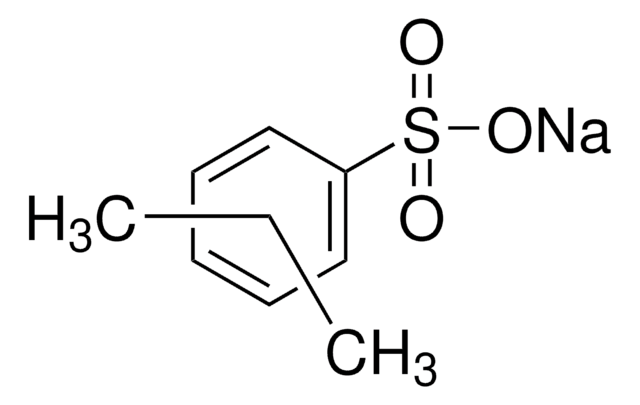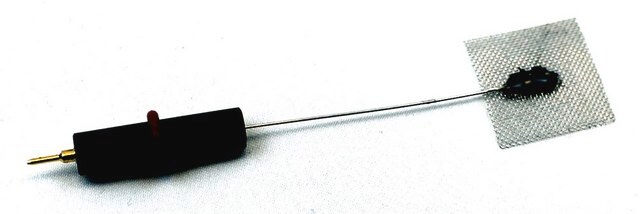267244
Platinum
foil, thickness 0.025 mm, 99.9% trace metals basis
Sinónimos:
Platinum element, Platinum gray
Iniciar sesiónpara Ver la Fijación de precios por contrato y de la organización
About This Item
Fórmula empírica (notación de Hill):
Pt
Número de CAS:
Peso molecular:
195.08
Número CE:
Número MDL:
Código UNSPSC:
12141734
ID de la sustancia en PubChem:
NACRES:
NA.23
Productos recomendados
Nivel de calidad
Análisis
99.9% trace metals basis
formulario
foil
resistividad
10.6 μΩ-cm, 20°C
grosor
0.025 mm
bp
3827 °C (lit.)
mp
1772 °C (lit.)
densidad
21.45 g/cm3 (lit.)
cadena SMILES
[Pt]
InChI
1S/Pt
Clave InChI
BASFCYQUMIYNBI-UHFFFAOYSA-N
Categorías relacionadas
Descripción general
This platinum foil is a thin sheet of platinum with a thickness of 0.025 mm and high chemical purity. Platinum is a dense, silver-white metal that is highly resistant to corrosion and has a high melting point. Platinum is a precious metal that is valued for its rarity and chemical stability, and is often used in jewelry, coins, and other decorative objects. In material science, it is often used as electrodes in fuel cells, batteries, and other electrochemical devices, as a substrate for electroplating, and as an inert crucible or dish among other applications.
Aplicación
Platinum foil can be used for a variety of applications such as:
- growth of high crystalline boron nitride (BN) material for UV optoelectronic devices.
- fabrication of electrochemically stable microelectrode arrays
- a counter electrode for the fabrication of supercapacitors
- an enzyme electrode probe for potential usage in biosensors
Cantidad
350 mg = 25 × 25 mm; 1.4 g = 50 × 50 mm
Código de clase de almacenamiento
13 - Non Combustible Solids
Clase de riesgo para el agua (WGK)
nwg
Punto de inflamabilidad (°F)
Not applicable
Punto de inflamabilidad (°C)
Not applicable
Elija entre una de las versiones más recientes:
¿Ya tiene este producto?
Encuentre la documentación para los productos que ha comprado recientemente en la Biblioteca de documentos.
Los clientes también vieron
Electrodeposition of nickel hydroxide films on nickel foil and its electrochemical performances for supercapacitor
Fu GR, et al.
International Journal of Electrochemical Science, 4(8), 1052-1052 (2009)
Pt based enzyme electrode probes assembled with Prussian Blue and conducting polymer nanostructures
Curulli A, et al.
Biosensors And Bioelectronics, 20(6), 1223-1232 (2004)
Muhammad Rashid et al.
Journal of nanoscience and nanotechnology, 13(5), 3627-3633 (2013-07-19)
Platinum nanoparticles (Pt NPs) were chemically deposited on a Nafion polymer electrolyte membrane by the impregnation-reduction (I-R) procedure to prepare an active electrode for solid electrochemical sensors. Various analysis methods such as SEM, EDX, XRD and cyclic voltammogram (CV) measurements
Wei Sun et al.
Materials science & engineering. C, Materials for biological applications, 33(4), 1907-1913 (2013-03-19)
In this paper a platinum (Pt) nanoparticle decorated graphene (GR) nanosheet was synthesized and used for the investigation on direct electrochemistry of myoglobin (Mb). By integrating GR-Pt nanocomposite with Mb on the surface of carbon ionic liquid electrode (CILE), a
Loris De Cecco et al.
PloS one, 8(3), e58849-e58849 (2013-03-14)
We recently reported that peritumoral CpG-ODN treatment, activating TLR-9 expressing cells in tumor microenvironment, induces modulation of genes involved in DNA repair and sensitizes cancer cells to DNA-damaging cisplatin treatment. Here, we investigated whether this treatment induces modulation of miRNAs
Nuestro equipo de científicos tiene experiencia en todas las áreas de investigación: Ciencias de la vida, Ciencia de los materiales, Síntesis química, Cromatografía, Analítica y muchas otras.
Póngase en contacto con el Servicio técnico




